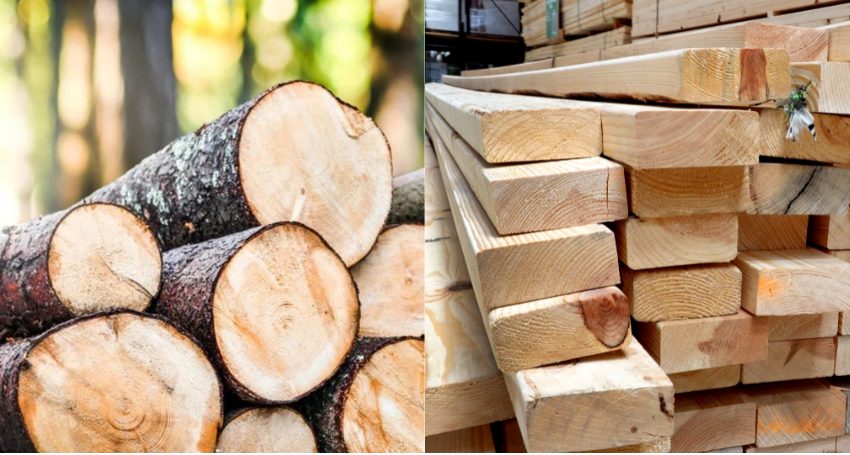
Timber vs. Lumber: Understanding the Distinctions
Introduction
In the world of construction and woodworking, people often use the terms ‘timber’ and ‘lumber’ interchangeably, but they represent distinct facets of the industry. Because Timber and lumber play vital roles in building and crafting and with each having its unique characteristics and uses. Further In this comprehensive guide, we will delve into the differences between timber vs lumber, while also highlighting the contributions of H.S Group, a leading company in the industry of exporters, in exporting building materials.
Timber: The Natural Beauty
What is Timber?
The term “timber” describes wood that is still in its natural state but is typically sourced from forests. It encompasses logs, planks, and beams that have not yet undergone industrial processing, and it retains the original features of the tree, including bark, knots, and grain patterns.
Characteristics of Timber
- Natural Aesthetics: People cherish timber for its natural beauty. The presence of knots, imperfections, and unique grain patterns adds character to timber products.
- Sustainability: Timber is often harvested from sustainably managed forests and making it an environmentally friendly building material.
- Versatility: Timber can be used for various applications, including furniture, flooring, and structural components.
Lumber: Processed and Refined
What is Lumber?
Typically, mill and plane wood that has undergone processing and manufacturing to create standardized and dimensioned pieces suitable for construction and woodworking to achieve consistent sizes and shapes. It refers to lumber.
Characteristics of Lumber
- Uniformity: Lumber is prized for its uniformity and making it easy to work with in construction projects.
- Smooth Finish: The planing and processing of lumber result in a smooth and polished surface.
- Structural Integrity: Lumber is often used in load-bearing applications due to its consistent strength.
The Distinctions: Timber vs. Lumber
1. Natural State vs. Processed State
The primary distinction between timber and lumber lies in their state of processing. But Timber remains in its natural state, retaining the unique characteristics of the tree, And while lumber is processed and refined to achieve uniformity and smoothness.
2. Aesthetics vs. Practicality
People choose timber for its aesthetic qualities, adding character to finished products with its natural imperfections. On the other hand, people favor lumber for its practicality and consistency, making it ideal for structural applications.
3. Sustainability vs. Manufacturability
People often associate timber with sustainable forestry practices, but people source it from well-managed forests. Lumber, due to its processing, relies on efficient manufacturing processes to optimize usability and minimize waste.
H.S Group: A Prominent Exporter of Building Materials
H.S Group has established itself as a prominent exporter of building materials, catering to the global construction and woodworking industries but With a commitment to quality and sustainability, H.S Group has become a leading company in the industry of exporters.
Exporting Building Materials
H.S Group specializes in exporting a wide range of building materials and including timber and lumber and to meet the diverse demands of international markets. So Their comprehensive product range includes:
- Timber: H.S Group exports timber sourced from responsibly managed forests, ensuring high-quality and sustainable building materials for construction and woodworking projects.
- Lumber: The company also offers a variety of lumber products, milled to precise dimensions, providing consistency and structural integrity for building applications.
Commitment to Sustainability
H.S Group recognizes the importance of sustainable sourcing and manufacturing. But They prioritize partnerships with suppliers who adhere to responsible forestry practices and contributing to the preservation of natural resources and the environment.
Quality Assurance
As a leading company in the industry of exporters, H.S Group places a strong emphasis on quality assurance beacause Their rigorous quality control processes ensure that every shipment meets international standards and guaranteeing the satisfaction of their customers.
The Choice: Timber vs Lumber?
The choice between timber and lumber ultimately depends on the specific requirements of a project and personal preferences.
Choose Timber If:
- You value the natural aesthetics and character of wood.
- Your project allows for the incorporation of knots and imperfections.
- Sustainability and eco-friendliness are priorities for you.
Choose Lumber If:
- Uniformity and consistency are critical for your project.
- You require a smooth and polished finish.
- Structural integrity is a top concern.
In many cases, builders or woodworkers may use a combination of timber and lumber to balance aesthetics and practicality in a construction or woodworking project.
Conclusion
Timber and lumber are two essential building materials that serve distinct purposes in construction and woodworking beacause Timber, in its natural state, celebrates the beauty of wood, while lumber, processed and refined, But offers uniformity and structural reliability. So The choice between the two depends on the specific requirements of a project.
H.S Group, a leading company in the industry of exporters, plays a significant role in providing high-quality building materials to global markets. Their commitment to sustainability and quality assurance ensures that timber and lumber sourced from them meet the diverse demands of the construction and woodworking industries worldwide. Whether you opt for the natural allure of timber vs lumber so the both choices find their place in the world of building and craftsmanship.

